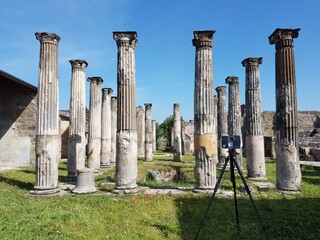PA_20180813_Pompeji
Press Release
NEW DISCOVERIES FROM ANCIENT POMPEII
The OeAI is studying a key location for the beginning of the urban history
(Vienna, August 13, 2018) – An interdisciplinary team from the Austrian Archaeological Institute (OeAI) of the OeAW is currently investigating the history of the casa di Arianna and its neighboring houses. The buildings are located directly north of the »Old Town« and are thus a key location for the understanding of the urban development of Pompeii, particularly for the early phases in the history of the city and the specific history of use of the area.
The Casa di Arianna: a key to the beginnings of the city
The exploration of ancient daily life and its modern interpretation are to a large extent informed by the architecture and the spectacular finds from Pompeii. Already since the 18th century the largest contiguous city ruin of European antiquity has been slowly freed from the masses of ashes from the eruption of Vesuvius in 79 CE. Despite its long research history the beginnings of the city are still largely unexplored. The study of the early phases of the city will reveal valuable insights into the development of urban life in lower Italy and the multi-faceted cultural exchange processes between the various population groups in Italy. The new project of the Austrian Archaeological Institute (OeAI) of the OeAW will contribute to the study of this question with a new project partnering with the research project »Casa di Arianna« of the Archaeological Institute of the city of Valencia, Spain. A key to the beginnings of Pompeii can be observed in the construction and usage history of the area where the casa di Arianna, one of the most monumental residences 1700m² in size, was later constructed. The work of the OeAI began with the detailed documentation of the house walls down to the cellar in order to study the connections in the construction history of the house and its surroundings. For the first time, a deformation-true inventory of the architecture was carried out in the casa di Arianna using 3D-laser scanning, drone flights, photogrammetric procedures, and traditional drafting.
Growth and change
In its first iteration the casa di Arianna was constructed in the 2nd century BCE to the north of the »Old Town« of Pompeii. It is part of a block of houses that established a balance between the small-scale road network of the »Old Town« and the regularly gridded Regio VI, an urban quarter in northwestern Pompeii. One of the main questions of the project will be the extent to which the progressive development of this housing block respected the older structures or older spatial organization, such as the course of streets or fortification systems.
The growth of the city also led to urban changes, such as the emergence of inner-city businesses. Together with the Spanish colleagues the OeAI is studying the large amount of preserved pottery with a focus on transport amphorae that were mainly used for transporting, storing, and processing wine, oil, or fish sauces in order to gain more information about the use of the casa di Arianna. Amphorae are considered to be an important source of information for the understanding of the ancient food industry and trade and as a result we are hoping to gain a lot of new insights from this research focus.
Contact
Astrid Pircher
Public Relations
T (+43 1) 4277-27144
E astrid.pircher(at)oeai.at
Alexander Sokolicek
Project lead Pompeji
T (+43) 0664 3501743
E alexander.sokolicek(at)oeai.at
